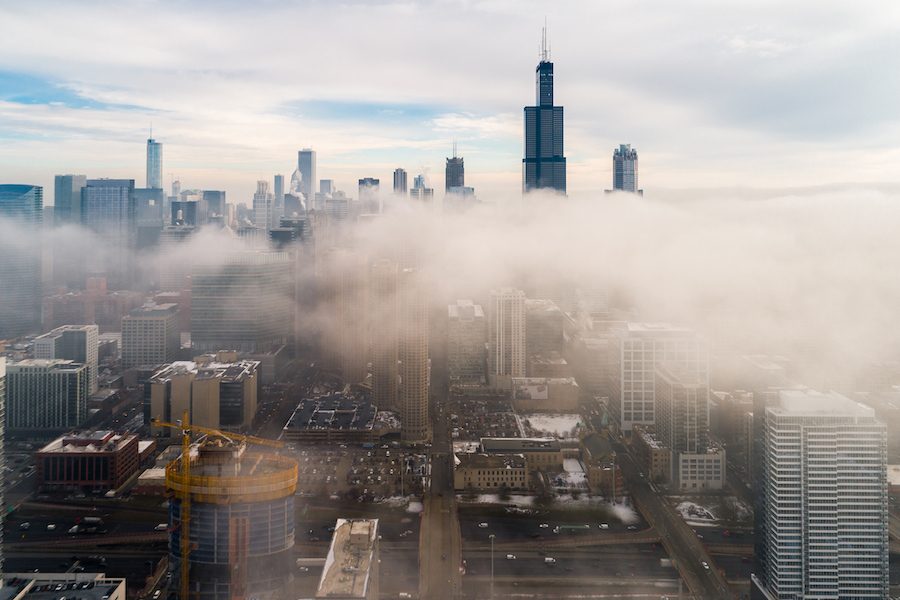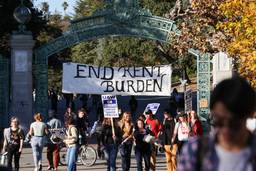Cities Aren’t Waiting for a Federal Green New Deal
Activists are pushing sweeping climate action at the local level.
Indigo Olivier

In 1992, recognizing that not all countries had contributed equally to the climate crisis, parties to the United Nations Framework Convention on Climate Change codified the principle of “common but differentiated responsibilities.” This framework insists that developed countries “take the lead in combating climate change” by transitioning to clean energy more rapidly, in order to allow time for developing nations to catch up to the same standard of living.
But it’s not just countries that are disproportionately liable for decades of emissions. One hundred cities account for nearly a fifth of our global carbon footprint. Three of the top 10 are in the United States: New York (3), Los Angeles (5), and Chicago (8) — these cities alone make up nearly 10% of U.S. emissions.
This may seem counterintuitive. Dense cities, after all, are more energy efficient and data suggests that per capita emissions actually decrease with urban population growth. But after analyzing the carbon footprints of over 13,000 cities around the world, one study found that combined high population and high income made cities disproportionately high emitters.
Within wealthy cities, high-consumption lifestyles drive emissions, and those lifestyles are shaped by the architecture of our urban environment. Everything from the shape of the city and the length of commutes to bike- and pedestrian-friendliness, robustness of public transportation (and/or highway) infrastructure, and the physical buildings themselves drive emissions. Rather than simply insisting people change their lifestyles to tackle the climate crisis, we need to insist on changing the cities that shape those lifestyles. And — with the federal government unlikely to pass a Green New Deal until at least 2021 — a number of cities are starting to do just that.
Just ahead of Earth Day, the New York City Council passed a historic package of climate legislation that many have called a Green New Deal for New York City. At the center of the Climate Mobilization Act is a bill that mandates buildings over 25,000 square feet reduce emissions 40% by 2030 and 80% by 2050. Behind the scenes, grassroots organizers had been forming a diverse coalition that united low-income communities of color with predominantly white climate activists over a period of several years. “In the end we won because of the coalition building and campaign work that we did,” says Pete Sikora, Climate & Inequality Campaigns Director for New York Communities for Change.
Buildings account for nearly 70% of carbon emissions in New York City, which has the largest carbon footprint of any urban area in the country. The city plans on implementing the policy through the creation of a new Office of Building Energy and Emissions Performance which would set performance standards, monitor building energy use and emissions, and determine penalties for buildings that fail to comply.
“There is no way to address the [energy] grid or the radical change needed to reach massive pollution cuts without prioritizing energy efficiency,” Sikora says. The goal is to reduce energy use to such a degree that large buildings, which often rely on fossil fueled-powered boilers and gas for heat and cooking, could be fully powered by the electric grid.
The importance of addressing buildings in general cannot be overstated. Globally, building operations, materials and construction account for nearly 40% of energy use. According to Architecture 2030, the global building stock will double by 2060. “This,” they say, “is the equivalent of adding an entire New York City every month for 40 years.”
While the federal government can set national emissions targets and provide federal funds to cities, much will be left to local governments to monitor and enforce energy efficiency standards — a task too big for the federal government to handle alone.
In July, Berkeley, Calif., became the first city in the United States to ban natural gas use in new buildings. Thirteen other cities across California followed shortly after, enacting new building codes that either require or encourage new construction to be run completely on electricity. In Philadelphia, organizers are pressuring the city council to pass similar legislation. This marks a significant first step towards long-term, government-enforced emissions standards. These progressive cities across the country are beginning to establish what will hopefully become a new normal.
Even with fossil fuel use eliminated within buildings, though, electricity is still only as clean as the grid that supplies it. In New York state, a grassroots organizing coalition successfully pushed for a recent state law requiring the grid to be 70% powered by renewable energy by 2030 and emissions-free by 2050. And around the country, local progressive groups are hard at work trying to put electric utilities under public ownership. The Chicago chapter of the Democratic Socialists of America (DSA) has been waging a fierce campaign, in collaboration with some of the city’s six socialist city council members, to bring their main electric utility company, ComEd, under municipal control. Similar DSA campaigns to take back the grid have appeared in New York City; Boston; New Haven, Conn.; East Bay, Calif.; and Providence, R.I.
“Our main campaign is energy democracy and we see that as a key aspect of winning a Green New Deal” say Sydney Ghazarian, who serves on the steering committee of DSA’s National Ecosocialist Working Group, which she helped found in 2017. (Full disclosure: This author is a member of DSA, though not involved with the ecosocialist working group.)
She and a few other members, Ghazarian says, “realized that [the climate crisis] was going to be the ultimate contradiction of capitalism” and would “require massive restructuring so socialists needed to be on the forefront of this issue.” The first priority for the Ecosocialist Working Group was infrastructure to implement municipal-level climate campaigns in local DSA chapters.
“We can’t wait until 2021 to start,” Ghazarian says. “What we can do is actually make real changes at the city level and the local level to start [the transition].” While supporting candidates like Sen. Bernie Sanders (I-Vt.), who is pushing for a national Green New Deal, DSA chapters have also been on the ground organizing a working-class base of supporters by engaging with people where they are: overwhelmingly, in cities.
There is an additional political advantage to organizing at the city-level: dense urban areas, to a great degree, are more inclined to vote blue than their rural counterparts. And enough large cities, accounting for much of the country’s population, taking serious climate action can put pressure on the federal government to pass decisive legislation.
Over 1,200 cities around the world have already declared a state of “climate emergency,” Oxford Dictionary’s 2019 word of the year. It’s a necessary first step and one national governments have been disinclined to take. “We have to shift into emergency mode,” says Laura Berry, research and publications director at The Climate Mobilization (TCM), which has helped lead this movement through their Climate Emergency Declaration campaign.
The goal of the organization is to catalyze a World War II-scale mobilization to reverse the climate crisis. In 2016, Bernie Sanders embraced TCM’s demand, and helped introduced it to the Democratic Party platform. But when Trump won the election, the organization shifted its focus to the local level. With Republicans holding the White House, Senate and a majority of state legislatures, cities are proving the best option for short-term change.
The organization has laid out a template for local government to declare a state of emergency with the hopes of “building upward.” “Federal and international negotiations have been incredibly ineffective in addressing the crisis that we are facing,” Berry says. “We see local governments as playing a really important role in advocating and pushing for stronger action at the state and national level.”
Nothing can substitute the need for international cooperation or a federal Green New Deal. But without municipal efforts to cooperate and enforce climate legislation, many of these policies, to borrow a pun from Sikora, will just be blowing a lot of hot air.
Indigo Olivier is a reporter-researcher for The New Republic and a 2020-2021 Leonard C. Goodman investigative reporting fellow. Her writing on politics, labor and higher education has appeared in the Guardian, The Nation and Jacobin, among other outlets.








